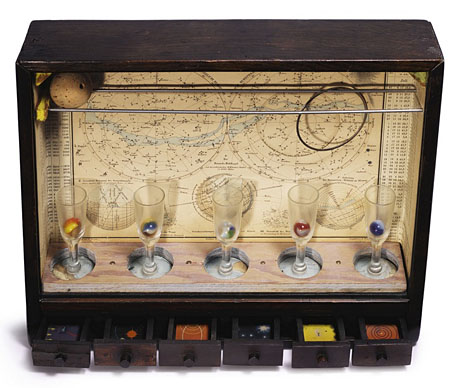
Untitled (Die Sternen-Welt), c.1950.
Among my current reading is Utopia Parkway (1997), Deborah Solomon’s biography of American artist Joseph Cornell (1903–1972). The book is very good for the factual data but I’ve been less enamoured by Solomon’s attempts to dredge biographical significance from Cornell’s hermetic and allusive work, or by her dismissive comments about other artists. Her account is most valuable when showing the evolution of Cornell’s art, the way he developed his often erratic and hesitant working methods. Most of Cornell’s works that I’ve seen in the past have been solitary examples, usually in books about Surrealism, so I wasn’t aware that so many of his celebrated and influential box assemblages were produced as themed series: Aviaries, Dovecotes, Hotels, and so on.
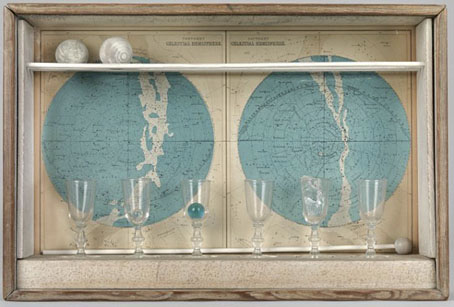
Planet Set, Tête Etoilée, Giuditta Pasta (dédicace), 1950.
Astronomy was a Cornell passion which also provided the subject for another themed series, Observatories, a collection of boxes begun later in his career for which star maps and heavenly bodies were the dominant concern. By the 1950s his creations were much more refined than some of his earlier constructions, although the box contents include many familiar Cornell ingredients: antique maps and diagrams, glassware, spherical objects, etc. The examples here are a small selection of those to be found scattered around various websites. Another consequence of reading Solomon’s book is realising that I could do with a companion volume filled with Cornell’s artwork. There doesn’t seem to be a decent monograph as yet; if anyone has any suggestions (preferably with colour plates) then please leave a comment.
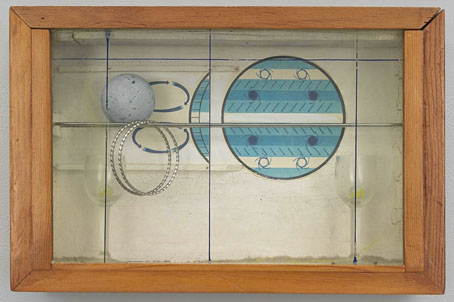
Sun Box (1950). [Not a constellation, obviously, but from the same astronomical series.]

Untitled (Celestial Navigation), 1956–58.
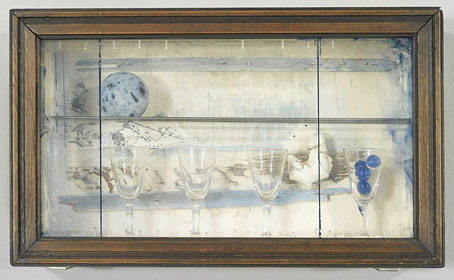
Celestial Navigation (c.1958).
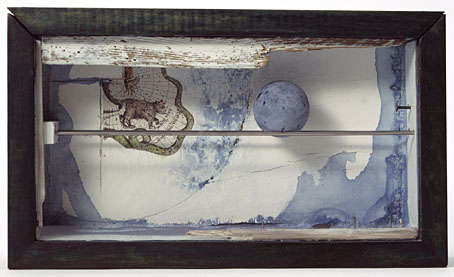
Untitled (Canis Major Constellation), c.1960.
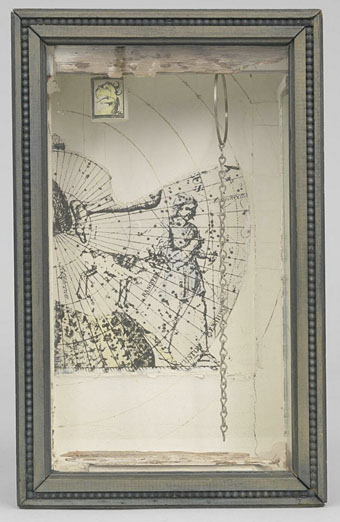
Custodian—M.M. (1962).
Previously on { feuilleton }
• Joseph Cornell: Worlds in a Box
• Joseph Cornell, 1967
• Rose Hobart by Joseph Cornell
• View: The Modern Magazine

Joseph Cornell: Wanderlust (Royal Academy exhibition catalogue, 2015)
Joseph Cornell: Shadowplay Eterniday (Thames & Hudson, 2003)
Joseph Cornell: Master of Dreams by Diane Waldman (Abrams, 2002)
Joseph Cornell (MOMA exhibition catalogue, 1980)
Top 2 particularly good. The American poet Charles Simic also wrote a nice little book about Cornell, Dime-Store Alchemy, which was published by New York Review Books.
There is an article that I occasionally revisit entitled BASEMENT BOYS, which examines how individuals like Cornell, Guy Maddin, Bruno Schulz, et cetera, mythologized their childhoods and their hometowns, finding the fantastical and cosmic within the provincial and personal, like Joyce’s idea of penetrating the heart of Dublin to find the heart of all cities. I have never liked that hoary adage, ”Write what you know,” because one may not know very much. Rather, one should write about what one does not know about. I am aware, of course, that this creates a fallacy: one now knows the subject one is writing about, but I suppose this ties in with the subject of autodidacts. Artists like Cornell and Schulz and Blake fascinate me because, though they were often rooted to the one place, their works expressed a universal spirit, and a relatively uneventful life did not affect their fantastic imaginations.
The link for the article is below, if you are interested:
https://believermag.com/logger/basement-boys/
My apologies if it does not work.
David: Many thanks, I’d been looking at reviews of some of those for future purchase but I didn’t know about the Royal Academy catalogue.
Liam: Cornell stayed in one place but he certainly wasn’t defined by it. Much of his art seemed to provide a mental escape from his stifling home situation, oppressed by the needs to care for his invalid brother while also evading harassment by his mother. “Wanderlust” was another recurrent theme (hence the title of the recent Royal Academy show) even though he seldom wandered very far.
“The book is very good for the factual data but I’ve been less enamoured by Solomon’s attempts to dredge biographical significance from Cornell’s hermetic and allusive work, or by her dismissive comments about other artists.”
I had EXACTLY the same reaction when I read this book – I’m glad it’s not just me! It seems to betray a peculiar lack of confidence in her subject, as if the only way that the author feels she can make Cornell seem good is by asserting that every other artist is bad. Which is both foolish and unnecessary, of course. Perhaps I’ll seek out those other book recommendations.
UbuWeb also has a selection of the great man’s films, as I recall.